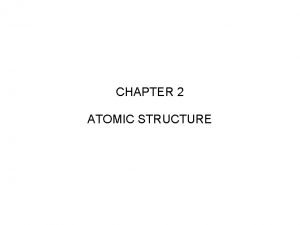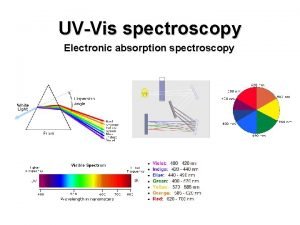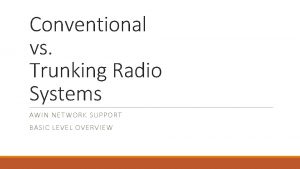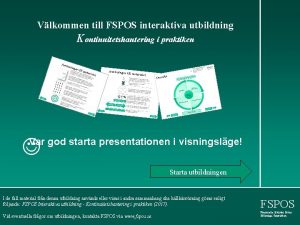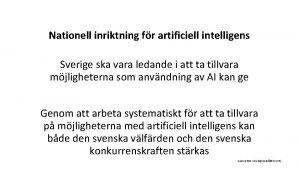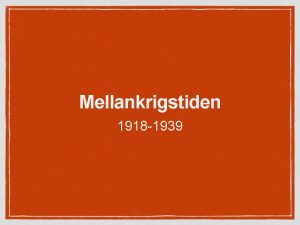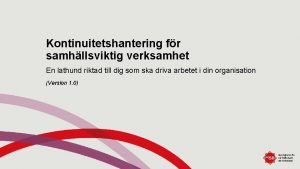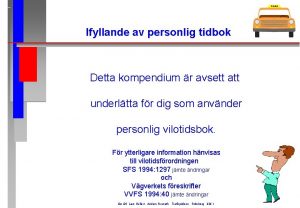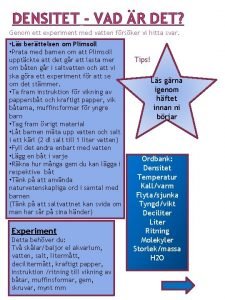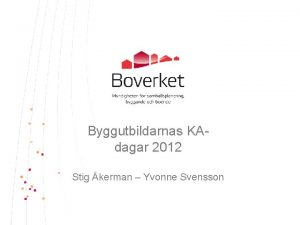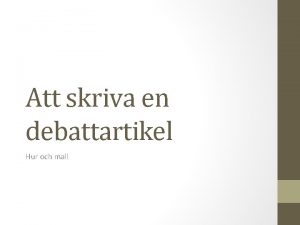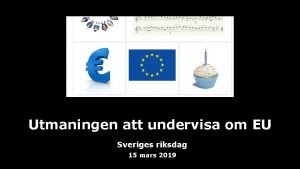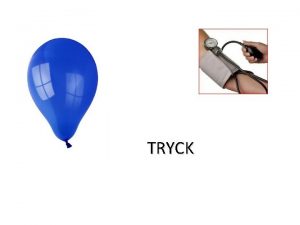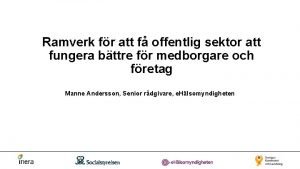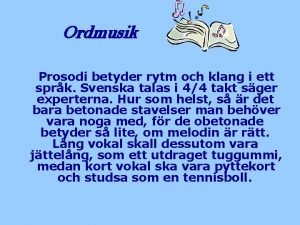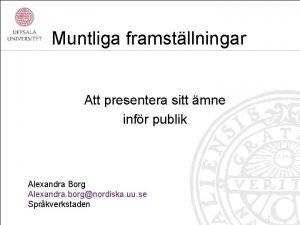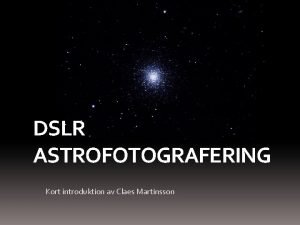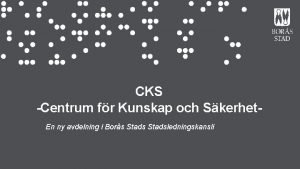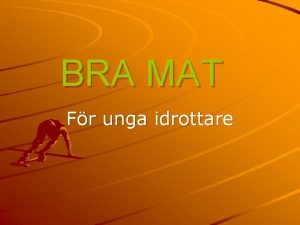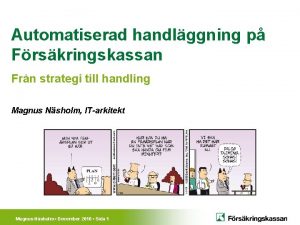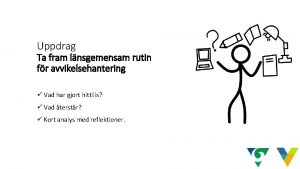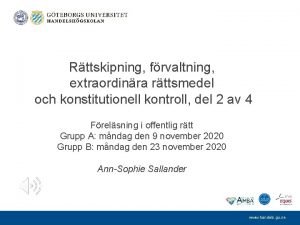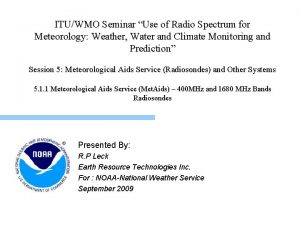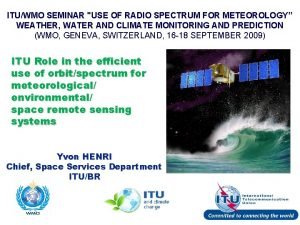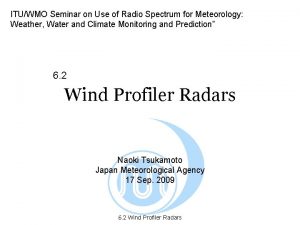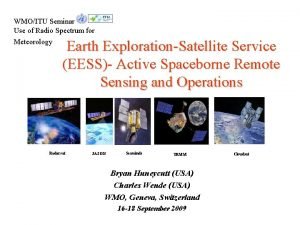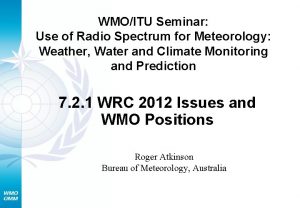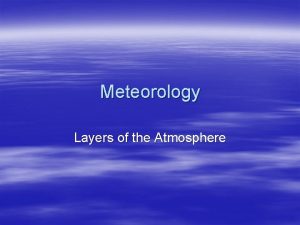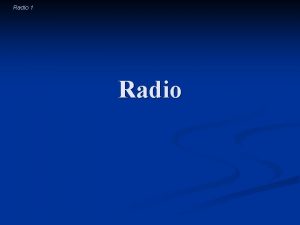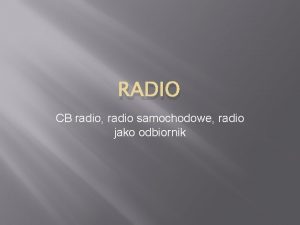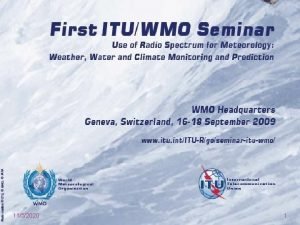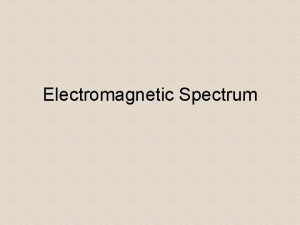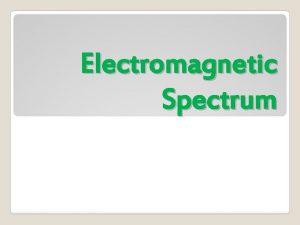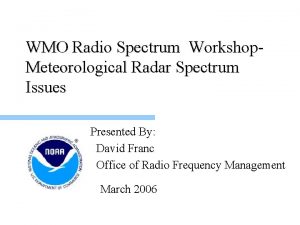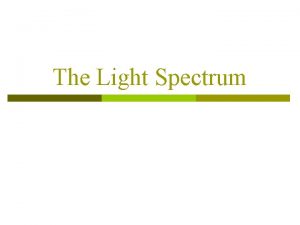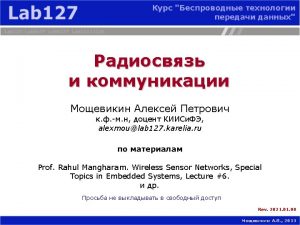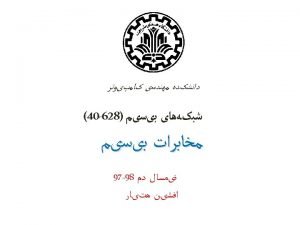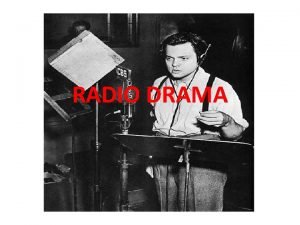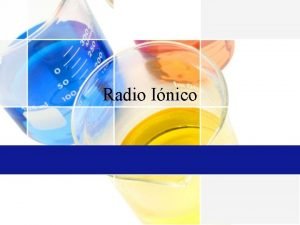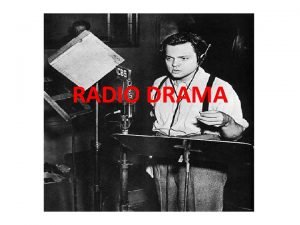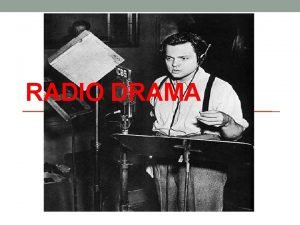ITUWMO Seminar Use of Radio Spectrum for Meteorology



































- Slides: 35

ITU/WMO Seminar “Use of Radio Spectrum for Meteorology: Weather, Water and Climate Monitoring and Prediction” Session 6: Meteorological Radars 6. 1. 1 Weather Radars Presented By: R. P Leck Earth Resource Technologies Inc. For : NOAA-National Weather Service September 2009

Meteorological Radars Agenda Weather Radars – Frequency Bands – System Overview – Operations – Data Utilization – Impact of Interference l Relevant ITU Documents l Looking Forward l Conclusions l 2

Weather Radars Frequency Bands Weather Radar Frequency Bands Frequency band (MHz) Band Name 2 700 -2 900 S-Band 5 250 -5 725 (Mainly 5 600 -5 650 MHz) 9 300 -9 500 C-Band X-Band 3

Weather Radars System Overview S-Band l l l Operate in the 2700 -2900 MHz Band In the US, WSR-88 Ds operate up to 3000 MHz Typical peak transmitter power is ~750 k. W 300 km Range Best Severe Weather Performance 159 operational S-Band NEXRAD Radars form the backbone of the US Severe Weather Warning System 4

Weather Radars System Overview C-Band (Commercial) l l l Operates within the 52505725 MHz Band (Primarily between 5600 -5650 MHz) Typical transmitter power is ~270 k. W ~200 km Range C-Band System are widely deployed on a worldwide basis Used by many TV Stations 5

Weather Radars System Overview C-Band (Government) l l l FAA operates 45 Terminal Doppler Weather Radar (TDWR’s) systems at or near major airports in the US Operates within the 5500 -5650 MHz Band Typical transmitter power is ~270 k. W ~90 km Range Detects hazardous weather conditions such as windshear, microbursts and gust fronts, tornadic winds and heavy precipitation (inferring thunderstorms at an airport) 6

Weather Radars System Overview X-Band l l l l Operates within the 9300 -9500 MHz Band Typical transmitter power is 100 W to 25 k. W ~50 km Range Element of Center for Collaborative Adaptive Sensing of the Atmosphere (CASA) network Users of X-Band Weather Radars include: l TV stations l Military l Researchers Small physical size Low Cost compared to S or C Band Systems 7

Weather Radars Operations US NEXRAD Network l l l Started Service in June 1992 159 Network Sites selected to provide overlapping coverage Super Resolution Upgrade Began in June 2008 increased Doppler Data Range to 300 km from 230 km Provides Nationwide Reflectivity Mosaic Generates multiples levels of data which include…. – – l Level II data - meteorological base data quantities: reflectivity, mean radial velocity, and spectrum width. 41 meteorological analysis products known as Level III data are generated from the Level II Data. The data are sent to the National Climatic Data Center (NCDC) for archiving and dissemination. A detailed description of these products can be found at http: //lwf. ncdc. noaa. gov/oa/radarproducts. html NEXRAD data is also used in hydrology, ecology, and environmental studies. 8

Weather Radars Operations European Network (OPERA – Operational Program for the Exchange of weather RAdar information) 150 Weather Radars l Supported Within the OPERA Network l Approximately 100 Doppler Radars l Dual-Polarization is becoming the operational standard. l 9

Weather Radars Operations Present and Future Frequency Band Needs l Band selection is a function of the trade offs between range reflectivity and cost which vary as a function of the physics of rain attenuation. – S-Band (2700 -2900 MHz) is well suited for detecting heavy rain at very long ranges. (Up to 300 km) – C-Band (5600 -5650 MHz) represents a good compromise between range and reflectivity and cost and can provided rain detection up to a range of 200 km – X-Band ( 9300 -9500 MHz) weather radars are… • More sensitive than S or C Band Radars Used for short range weather observations up to a range of 50 km 10

Weather Radars Operations Data Utilization – Base Products l l Single Polarization l Weather Forecasting Products l Base Reflectivity – Rainfall Rate l Mean Radial Velocity - Wind information that related to wind motions within and relative to a storm Used for assessing rotation in a storm. l Spectrum Width – Detecting turbulence Dual Polarization l Differential Reflectivity - Indicator of drop shape. l Correlation coefficient – Indicator of regions where the is a mixture of precipitations types. l Specific Differential Phase – Also a good indicator of rain rate 11

Weather Radars Operations Impact of Interference l l l Corrupts Base Products Limits or nullifies the Radars Ability to…. l Detect wind speed and direction l Locate and track hurricanes, typhoons, tornados, gales l Provide reliable data to base severe storm or flash food warnings on. Decrease Range Base Reflectivity – Distorts Rainfall Rate Estimates Types of Interference l Constant l Time Varying l Pulsed l We continue to see interference despite trying to identify sources and mitigation strategies 12

Weather Radars Operations Impact of Interference – Types of Interference (Constant) Meteo-04 -9 13

Weather Radars Operations Impact of Interference – Types of Interference (Constant Interference from an RLAN) 14

Weather Radars Operations Impact of Interference – Types of Interference (Pulsed) Interference free Interference corrupted 15

Weather Radars Operations Impact of Interference – Types of Interference (Wind Farms) [[Wind farms not listed on Slide 11 as a type of interference]] l l l Thunderstorm characteristics could be masked or misinterpreted False reflectivity and radial velocity signatures could reduce forecaster's situational awareness during hazardous/severe weather events Data masking or contamination over the wind farm and down range from the wind farm may negatively impact warning effectiveness. False precipitation estimates could negatively impact flash-flood warning effectiveness Forecasters were able to ‘work around’ the impacts in this situation. Within ~18 km the impacts on data and operations begins to rapidly increase. Wind Farm 16

Weather Radars Operations Impact of Interference On Our Lives Routine weather forecasts l Severe weather and flash flood warnings l Aviation and maritime safety l – Personal travel safety – Safe, timely transport of personal and commercial goods Agriculture – your source of food l Power management l Highway management l Water management l 17

Weather Radars Operations Impact of Interference At the end of the day, the bottom line is that interference dramatically reduces a Meteorologists ability to generate reliable forecasts…. . 18

Weather Radars Operations Impact of Interference – Protection Criteria l Interference Protection Criteria: The highest interference level that does not degrade the system performance beyond performance requirements

Weather Radars Operations Impact of Interference – Interference To Noise I/N Protection Criteria I/N is specified as a interference signal level relative to the radar noise floor l Interference is added to receiver noise to produce a higher noise + interference level l Higher noise + interference level masks and corrupts weak but vital returns l The current ITU-R protection criteria Level for Meteorological Radars is an I/N of -10 d. B. l

ITU Definitions Weather Radars l l l International Telecommunications Union (ITU) – U. N. organization responsible for international regulation of radio spectrum use International Radio Regulations – Treaty text maintained and enforced by the ITU that provides the regulations and table of frequency allocations for international radio spectrum use Radio Service - A type of radio operation, such as meteorological satellites, broadcasting, mobile-satellite Allocation – The authority for a radio service to use a particular frequency band License (or Assignment) – Authority for a particular radio station to use a specific frequency under the defined technical conditions and consistent with a frequency allocation 21

ITU Definitions Applied To Meteorological Radars Meteorological Aids Service (Met. Aids) – 400 MHz and 1680 MHz Bands Radiosondes In the ITU, Meteorological Radars fall under the Radiodetermination Service l ITU Working Party 5 B (WP 5 B) is responsible for Meteorological Radars. l Three allocations exist in the Radio Regulations specifically for meteorological radars – 2700 -2900 MHz- ground based radars – 5600 -5650 MHz- ground based radars – 9300 -9500 MHz- ground based and airborne radars l 22

Weather Radars Relevant ITU Documents Allocations l 5. 423 In the band 2700 -2900 MHz, ground based radars used for meteorological purposes are authorized to operate on a basis of equality with stations of the aeronautical radionavigation service [[3000? ]] l 5. 452 Between 5600 and 5650 MHz, ground based radars used for meteorological purposes are authorized to operate on a basis of equality with stations of the maritime radionavigation service l 5. 475 The use of the band 9300 -9500 MHz by the aeronautical radionavigation service is limited to airborne weather radars and ground-based radars. … In the band 9300 -9500 MHz, groundbased radars used for meteorological purposes have priority over other radiolocation services

Weather Radars Relevant ITU Documents Recommendation ITU-R M. 1464 -1 Content: Characteristics of meteorological radars and protection criteria for sharing studies l Use: Used for performing analysis between systems operating in the radiodetermination service operating in the frequency band 27002900 MHz l 24

Weather Radars Relevant ITU Documents Recommendation ITU-R M. 1849 Content: Technical and operational aspects of ground-based meteorological radars l Use: That the technical and operational aspects of meteorological radars as described in document be considered when conducting sharing studies and that the protection criteria for meteorological radars should be based upon Annex 1, in particular § 8. 5, for assessing compatibility with interfering signal types from other services and applications. l 25

Weather Radars Relevant ITU Documents Report TU-R M. 2136 Content: Interference protection criteria analysis and testing results in the 2700 -2900 MHz and 5600 -5650 MHz Bands l Use: Reference document l 26

Weather Radars Relevant ITU Documents Report TU-R M. 2136 Content: Interference protection criteria analysis and testing results in the 2700 -2900 MHz and 5600 -5650 MHz Bands l Use: Reference document l 27

Weather Radars Relevant ITU Documents Handbook R-HDB-45 -2008 -MSW-E Content: Use of Radio Spectrum for Meteorology: Weather, Water and Climate Monitoring and Prediction l Use: “The Handbook provides comprehensive technical and operational information l on current observation applications and systems and on the use of radio frequencies by meteorological systems, including meteorological satellites, radiosondes, weather radars, wind profiler radars and spaceborne remote sensing. It is intended for the meteorological (i. e. weather, water and climate) and radiocommunication communities, including governmental institutions, industry as well as the general public. ” 28

Looking Forward Future System Trends Weather Radar s Dual Polarization l Phased array antennas – Allow other volume scan strategies – Can periodically return to an area of concern in atmosphere during a volume scan l Increased automation – Mode selection – Severe weather signature detection l The deployment of X-band gap filler radars where short range (mitigating cone of silence) or high resolution performance is needed. l 29

Looking Forward Future ITU Activities Weather Radar s Updates to ITU-R Document ITU-R M. 1464 l New ITU-R Report on Determining Maximum Interference Levels for Dual. Polarization Radars Operating in the 27002900 MHz Band l 30

Conclusions Weather Radars Meteorological radars operate differently and produce different products than other radar types l The differences need to be considered when conducting sharing studies l Limitations of physics dictate frequency band use l Meteorological radars with higher sensitivity – lead to greater interference sensitivity l 31

Conclusions Weather Radars l Meteorological Radars are the backbone of day to day local, regional, national and global weather forecasting – Utilize segments of the Spectrum that are well suited to their operation – Provide data for local severe storm, aviation and marine forecasting – Save lives and injuries due to tornadoes – Simmons, K. M. and D. Sutter, 2005: WSR-88 D Radar, Tornado Warnings and Tornado Casualties – Sensitive systems that must be protected from interference

References Weather Radars Crum, T. D. and R. L. Alberty, 1993: The WSR-88 D and the WSR-88 D Operational Support Facility. Bull. Amer. Meteor. Soc. , 74, 1669 -1687. Doviak, R. J. and Zrnic, D. S. Doppler Radar and Weather Observations. Dover Publications Inc, Mineola, NY. 1993. Simmons, K. M. and D. Sutter, 2005: WSR-88 D Radar, Tornado Warnings and Tornado Casualties. Weather Forecasting, 20, 301 -310. Burgess, D. W. , T. Crum, and R. J. Vogt, 2008: Impacts of wind farms on WSR-88 D Operations. Preprints, 24 th Int. Conf. on Interactive Information Processing Systems (IIPS) for Meteorology, Oceanography, and Hydrology, New Orleans, LA, Amer. Meteor. Soc. , Paper 6 B. 3. Doppler Radar Meteorological Observations: Federal Meteorological Handbook No. 11, Parts A – D (contains general specifications and information on the NEXRAD radar) available at: http: //www. roc. noaa. gov/FMH_11/default. asp. Isom, B. M. R. Palmer, G. Secrest, R. Rhoton, D. Saxion, J. Reed, T. Crum and R. Vogt, 2008: Wind Turbine Clutter Characterization and Mitigation on Federal Weather Radars (NEXRAD). Poster, American Wind Energy Association WINDPOWER 2008, Houston, TX. Isom, B. M. , R. Palmer, G. Secrest, R. Rhoton, D. Saxion, J. Reed, T. Crum and R. Vogt, 2008: Detailed Observations of Wind Turbine Clutter With Scanning Weather Radars 33

References Weather Radars Palmer, R. , S. Torres, R. Zhang, 2008: Characterization, Detection, and Mitigating Wind Turbine Clutter on the WSR-88 D Network. Briefing to the NEXRAD Technical Advisory Committee Meeting, Sept 2008, available at: http: //arrc. ou. edu/~rpalmer/ppt/TACMeeting_WTC_Palmer. pdf V Vogt, R. J. , J. R. Reed, T. Crum, J. T. Snow, R. Palmer, B. Isom, and D. W. Burgess, 2007: Impacts of Wind Farms on WSR-88 D Operations and Policy Considerations. Preprints, 23 rd Int. Conf. on Interactive Information Processing Systems (IIPS) for Meteorology, Oceanography, and Hydrology, San Antonio, TX, Amer. Meteor. Soc. , Paper 5 B. 7. Vogt, R. J. , T. Crum, J. Reed, J. Sandifer, R. Palmer, B. Isom, J. Snow, D. Burgess and M. Paese, 2008: Weather Radars and Wind Farms – Working Together for Mutual Benefit. Poster, American Wind Energy Association WINDPOWER 2008, Houston, TX. Vogt, R. J. , T. Crum, J. Reed, J. Sandifer, et. al. : A Way Forward Wind-Farm Weather Radar Coexistence, American Wind Energy Association Project Siting Workshop, February 24 - 25, 2009, Seattle, WA Trisant, Philippe : Radio Frequency Threats on Meteorological Radars Operations, Proceedings of ERAD 2006, Fourth European Conference on Radar in Meteorology and Hydrology, September 18 -22, 2006, Barcelona, Spain ITU/WMO Handbook, Use of Radio Spectrum for Meteorology: Weather, Water and Climate Monitoring and Prediction, 2008 Edition 34

References Weather Radars ITU/WMO Handbook, Use of Radio Spectrum for Meteorology: Weather, Water and Climate Monitoring and Prediction, 2008 Edition Report ITU-R M. 2136, Theoretical Analysis and Testing Results Pertaining to the Determination of Relevant Interference Protection Criteria of Ground-Based Meteorological radars, ITU 2008 Report ITU-R M. 2112, Compatibility/Sharing if Airport Surveillance and Meteorological Radar wit IMT Systems within the 2700 -2900 MHz Band, ITU 2007 Recommendation ITU-R M. 1464 -1, Characteristics of Radiolocation Radars, and Characteristics and Protection Criteria for Sharing Studies for Aeronautical Radionavigation and Meteorological Radars in the Radiodetermination Service Operating in the Frequency Band 2700 -2900 MHz, ITU 2003 Recommendation ITU-R M. 1849, Technical and Operation Aspects of Ground Based Meteorological Radars, ITU 2009 35
 Copper subshell configuration
Copper subshell configuration Absorption spectrum vs emission spectrum
Absorption spectrum vs emission spectrum Spettro elettromagnetico
Spettro elettromagnetico Awin radio
Awin radio Fspos
Fspos Typiska drag för en novell
Typiska drag för en novell Nationell inriktning för artificiell intelligens
Nationell inriktning för artificiell intelligens Ekologiskt fotavtryck
Ekologiskt fotavtryck Varför kallas perioden 1918-1939 för mellankrigstiden?
Varför kallas perioden 1918-1939 för mellankrigstiden? En lathund för arbete med kontinuitetshantering
En lathund för arbete med kontinuitetshantering Kassaregister ideell förening
Kassaregister ideell förening Personlig tidbok
Personlig tidbok Sura för anatom
Sura för anatom Densitet vatten
Densitet vatten Datorkunskap för nybörjare
Datorkunskap för nybörjare Tack för att ni lyssnade bild
Tack för att ni lyssnade bild Hur skriver man en debattartikel
Hur skriver man en debattartikel För och nackdelar med firo
För och nackdelar med firo Nyckelkompetenser för livslångt lärande
Nyckelkompetenser för livslångt lärande Påbyggnader för flakfordon
Påbyggnader för flakfordon Vätsketryck formel
Vätsketryck formel Publik sektor
Publik sektor Jag har gått inunder stjärnor text
Jag har gått inunder stjärnor text Presentera för publik crossboss
Presentera för publik crossboss Teckenspråk minoritetsspråk argument
Teckenspråk minoritetsspråk argument Plats för toran ark
Plats för toran ark Treserva lathund
Treserva lathund Luftstrupen för medicinare
Luftstrupen för medicinare Bästa kameran för astrofoto
Bästa kameran för astrofoto Centrum för kunskap och säkerhet
Centrum för kunskap och säkerhet Programskede byggprocessen
Programskede byggprocessen Mat för idrottare
Mat för idrottare Verktyg för automatisering av utbetalningar
Verktyg för automatisering av utbetalningar Rutin för avvikelsehantering
Rutin för avvikelsehantering Smärtskolan kunskap för livet
Smärtskolan kunskap för livet Ministerstyre för och nackdelar
Ministerstyre för och nackdelar
